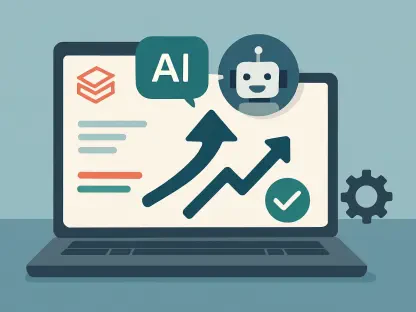As we approach 2025, the landscape of data management is undergoing significant transformations driven by advancements in artificial intelligence (AI), machine learning, and a heightened focus on sustainability and security. Organizations are increasingly leveraging these technologies to manage the growing volume of unstructured data and to foster a data-driven culture. This article delves into the anticipated trends and innovations shaping the future of data management.
The Rise of AI and Machine Learning in Data Management
Growth in Big Data and Unstructured Data
The big data industry is experiencing exponential growth, with projections indicating an increase from $220.2 billion in 2023 to $401.2 billion by 2028. This surge is largely driven by AI and machine learning technologies, which are enabling organizations to manage and analyze vast amounts of unstructured data. As data volumes continue to rise, businesses are investing in advanced analytics to extract meaningful insights and drive decision-making processes. Such an increase in data means that companies need more sophisticated tools to process and decipher the information, and AI and machine learning are offering novel approaches to address these challenges efficiently.
Furthermore, unstructured data, which comprises about 80% of the data businesses collect—such as text, images, and videos—presents unique challenges that traditional data management systems struggle to handle. AI and machine learning algorithms excel in parsing through vast swathes of data, identifying patterns, and uncovering insights that would be impossible for human analysts to spot. Organizations that successfully harness these technologies can gain a significant competitive advantage, as they can make more informed decisions, improve customer experiences, and innovate more rapidly. Advanced analytics enable the automation of routine tasks, freeing up experts to focus on more strategic work.
Democratization of Advanced Analytics
Gartner predicts that by 2025, advanced analytics processes will become more accessible and automated, allowing a broader audience within organizations to utilize complex analytics tools. This democratization of data insights aims to empower employees at various levels to leverage analytics in their daily operations. As a result, businesses can enhance collaboration, ensure data-driven decisions are integrated into everyday operations, and create a more inclusive culture. By making complex analytics more user-friendly, companies can help employees without data science backgrounds contribute to the organization’s data efforts.
Automation plays a pivotal role in this democratization. Tools that can automate data preparation, analysis, and visualization make it easier for non-experts to draw actionable insights from data. Additionally, AI-powered platforms are designed to offer suggestions and flag anomalies, guiding users through the analytics process. This shift promises to democratize data, making sophisticated analysis as integral to business operations as basic computational skills. Organizations that invest in these technologies and promote a data-savvy workforce can expect improved communication, faster decision-making, and increased adaptability in an ever-changing market landscape.
Emphasis on Data Literacy and Workforce Training
Bridging the Gap Between Data Specialists and Business Users
As data becomes a central asset for organizations, data literacy is emerging as a fundamental skill that companies need to cultivate among their workforce. Bridging the gap between data specialists and business users demands a concerted effort in training. Companies are investing heavily in programs designed to effectively teach employees how to read, understand, create, and communicate data. This investment is essential in promoting a more collaborative environment where data-driven decisions become the norm rather than the exception.
Successfully bridging this gap means that all employees, not just data scientists or IT personnel, can engage meaningfully with data. Training programs often span from foundational literacy courses to more advanced analytics training, ensuring that team members across different departments can contribute to the organization’s data strategies. This approach also helps to demystify data, making it less intimidating and more accessible for everyone. As a result, teams can collaborate more efficiently, integrating data insights into product development, marketing strategies, and customer relations, thus driving overall business performance.
Creating a Data-Driven Culture
To fully leverage the potential of data, organizations are focusing on creating a data-driven culture. This involves not only training employees but also integrating data insights into the core business processes. When data becomes an integral part of the decision-making framework, companies can ensure that resources and efforts are allocated based on solid evidence rather than intuition. By fostering an environment that prioritizes data-driven insights, businesses can enhance innovation, improve efficiency, and boost overall performance.
Creating such a culture requires top-down support from leadership, who must champion data initiatives and model data-driven decision-making. Additionally, accessible data governance policies and user-friendly tools contribute to maintaining this culture, ensuring that everyone within the organization can utilize data effectively. Over time, as businesses embed data into their strategies and operations, they can expect to see continuous improvement and growth driven by reliable, data-backed decisions. Ultimately, this cultural shift towards data-centric decision-making helps businesses stay competitive and agile, ready to respond to new challenges and opportunities in the evolving market landscape.
Sustainability in Data Practices
The Concept of the Green Cloud
Amidst technological advancements and the growing awareness of climate change challenges, the concept of the “green cloud” has gained prominence. Organizations are increasingly adopting eco-friendly technologies and practices in their cloud computing efforts to reduce their carbon footprints. This involves investing in energy-efficient cooling systems and utilizing advanced algorithms to manage workloads more effectively. By considering environmental impact in their data management strategies, businesses can contribute to global sustainability efforts while optimizing operational efficiency.
The green cloud concept goes beyond merely sourcing renewable energy for data centers. It involves comprehensive initiatives aimed at reducing data centers’ overall energy consumption and improving their environmental impact. Techniques such as server virtualization, which increases resource utilization efficiency, and intelligent infrastructure management, which adjusts power usage in real-time based on demand, are being adopted widely. Furthermore, organizations are exploring circular economy principles, such as reusing hardware components and materials, to extend the lifecycle of their data infrastructure, thereby reducing electronic waste.
Sustainable Practices in Cloud Computing
Businesses are increasingly focusing on sustainable practices to minimize their environmental impact as part of their broader corporate social responsibility initiatives. This shift involves optimizing data storage and processing to reduce energy consumption, implementing renewable energy sources, and adopting policies that promote sustainable practices throughout the organization. By aligning cloud computing strategies with sustainability goals, companies can achieve a balance between innovation and environmental stewardship.
Spearing the movement towards sustainability, many tech giants are pledging to power their data centers with 100% renewable energy within the next few years. Alongside this, energy-efficient hardware, improved data processing algorithms, and strategic data center locations in cooler climates are playing significant roles in reducing carbon footprints. Businesses that commit to these practices not only support environmental sustainability but also enhance their corporate image, attract environmentally conscious customers, and comply with increasingly stringent environmental regulations, ensuring a sustainable future for the data industry.
Enhancing Data Security
The Growing Threat of Cybercrime
Data security remains a paramount concern for organizations as cybercrime threats continue to evolve and become more sophisticated. According to reports from Forrester, cybercrime is projected to cost approximately $12 trillion by 2025, underscoring the urgent need for robust security measures. In response, regulatory bodies are becoming more proactive in protecting consumer data, enforcing stricter data protection laws, and implementing stringent compliance requirements. Organizations must adapt swiftly to these changing landscapes, adopting advanced security protocols to safeguard their data.
The rise of remote work and the increasing amount of sensitive information stored online have made businesses more vulnerable to cyber attacks. Cybercriminals are developing new tactics, such as ransomware and social engineering, to exploit weaknesses in security defenses. To counteract these threats, companies are implementing comprehensive cybersecurity strategies that include continuous monitoring, real-time threat detection, and rapid response plans. Additionally, employee training programs on cybersecurity best practices are essential in creating a resilient security culture within an organization, empowering employees to recognize and thwart potential threats.
Adoption of Zero Trust Architectures
One of the key strategies for enhancing data security is the adoption of zero trust architectures. Unlike traditional security models that assume trustworthiness within the network perimeter, zero trust principles require continuous verification of users, devices, applications, and data transactions, regardless of their network location. This approach ensures that even if a cybercriminal breaches the network, they cannot move laterally and access sensitive information without additional authentication. By implementing zero trust policies, organizations can enhance their data security and reduce the risk of cyber threats.
Zero trust architectures employ a multi-layered security strategy that includes identity verification, least-privilege access controls, and robust encryption. Advanced technologies such as multi-factor authentication (MFA), endpoint detection and response (EDR), and micro-segmentation are integral components of a zero trust framework. These measures ensure that access is granted only to verified users and devices, thereby minimizing the attack surface and mitigating potential security breaches. In an era of increasing cyber threats, adopting zero trust principles is crucial for organizations to protect their critical data assets and maintain trust with their customers.
Innovative Data Architectures
Data Fabric Architecture
Innovation in data architectures is addressing the complexity of data integration and management across diverse systems. One such innovation is the data fabric architecture, which provides a unified and consistent view of data, regardless of whether it resides on-premises, in the cloud, or in hybrid environments. By seamlessly integrating data from various sources, a data fabric framework allows organizations to manage and utilize their data more effectively, enhancing their ability to derive insights and make informed decisions.
The data fabric architecture simplifies data management by creating a virtual layer that connects disparate data sources, enabling users to access and analyze data without worrying about the underlying infrastructure. This approach improves data quality, consistency, and governance, ensuring that data is accurate and reliable. Moreover, data fabric enables organizations to implement advanced analytics and machine learning models more efficiently, as they can access a comprehensive and integrated view of their data. As data continues to grow in volume and complexity, adopting data fabric architectures will be essential for businesses to stay competitive and innovate.
Data Mesh Architecture
Data mesh represents another innovative approach to data management, emphasizing decentralization and domain-specific ownership. This model allows distinct teams within an organization to own, manage, and utilize their data independently, promoting scalability, flexibility, and resilience. By treating data as a product managed by domain-specific teams, data mesh ensures interoperability and seamless communication between different organizational units, fostering a more collaborative environment.
In a data mesh architecture, each domain team is responsible for the complete lifecycle of their data, from collection and processing to analysis and governance. This decentralized approach empowers teams to develop tailored data solutions that meet their specific needs, accelerating innovation and enhancing agility. Additionally, data mesh fosters a culture of accountability, as domain teams take ownership of their data quality and security. By implementing data mesh principles, organizations can create a scalable and resilient data infrastructure that adapts to the evolving demands of the business and drives data-driven decision-making.
Trend-Setting Products and Services
Highlighted Products in Data Management
To help organizations navigate the advancements in data management, DBTA (Database Trends and Applications) annually presents a list of trend-setting products. These products showcase a commitment to innovation and provide organizations with the tools necessary to address changing market requirements. Noteworthy platforms making the list include Acceldata’s ADOC Platform, Aerospike’s Graph, Airbyte’s Cloud, Alation’s Data Catalog, and Astronomer’s Astro.
Each of these products offers unique capabilities that enhance data management processes. For example, Acceldata’s ADOC Platform provides comprehensive observability across data operations, helping organizations monitor and optimize their data pipelines. Aerospike’s Graph supports scalable and high-performance graph data storage and querying, enabling advanced analytics for complex data relationships. Airbyte’s Cloud simplifies data integration with an open-source platform that facilitates data movement across various systems. Alation’s Data Catalog enhances data discovery and governance, empowering users to find, understand, and trust their data. Astronomer’s Astro streamlines data orchestration, enabling efficient management of data workflows in the cloud.
Insights from Industry Leaders
In addition to product highlights, industry leaders provide insights into how their solutions stand out from the competition. These products encompass various aspects of data management, from data integration and security to cloud-based solutions and AI-driven analytics. For instance, Elastic’s Elasticsearch, Empolis’ Service Express, FairCom’s DB, and Fivetran’s Data Movement Platform reflect the innovative approaches to managing and utilizing data effectively.
Elasticsearch is known for its powerful search and analytics capabilities, allowing organizations to quickly find and analyze large volumes of data. Empolis’ Service Express leverages AI to deliver intelligent customer support solutions, improving service efficiency and customer satisfaction. FairCom’s DB provides a high-performance multi-model database that supports various data models, offering flexibility and scalability for diverse data management needs. Fivetran’s Data Movement Platform simplifies data integration by providing automated pipelines that ensure data is continuously and accurately updated across systems. These industry-leading products demonstrate the diverse array of solutions available to address the evolving challenges of data management.
Conclusion
As we near 2025, the field of data management is undergoing major changes, driven by cutting-edge advancements in artificial intelligence (AI) and machine learning. These technologies, alongside a growing emphasis on sustainability and security, are revolutionizing how organizations handle data. Companies are increasingly adopting AI and machine learning to manage the rising volumes of unstructured data, promoting a culture that relies heavily on data-driven decisions. This shift not only enhances efficiency but also supports sustainable practices by optimizing resource use and reducing waste. Moreover, heightened security measures are being integrated to protect sensitive information from cyber threats. This article explores the anticipated trends and groundbreaking innovations that are set to reshape the future of data management, offering insight into how these advancements will impact various industries and drive them toward more intelligent and secure data handling practices.









